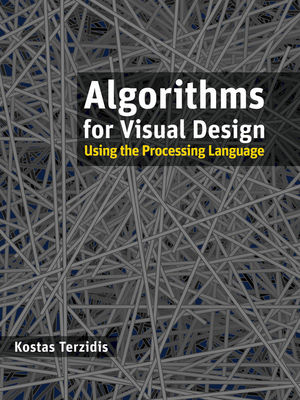Algorithms for Visual Design Using the Processing LanguageISBN: 978-0-470-37548-8
Hardcover
384 pages
May 2009
 This title is out-of-print and not currently available for purchase from this site.
|
Introduction xix
Chapter 1 Elements of the Language 1
1.1 Operands and Operations 2
1.1.1 Variable Types 2
1.1.2 Name Conventions 4
1.1.3 Arithmetic Operations 5
1.1.4 Logical and Relational Operations/Statements 7
1.1.5 Loops 8
1.1.6 Patterns of Numbers 10
1.2 Graphics Elements 12
1.2.1 Code Structure 12
1.2.2 Draw Commands 13
1.2.3 Geometrical Objects 13
1.2.4 Attributes 17
1.2.5 Fonts and Images 20
1.2.6 Examples 21
1.3 Interactivity 24
1.3.1 Drawing on the Screen 24
1.3.2 Mouse and Keyboard Events 26
1.4 Grouping of Code 28
1.4.1 Arrays 28
1.4.2 Procedures and Functions 30
1.4.4 Recursion 33
1.4.5 Importing Processing Classes 34
Summary 35
Exercises 35
Chapter 2 Points, Lines, and Shapes 41
2.1 Sine and Cosine Curves 42
2.2 Bezier Curve 47
2.3 Pointillist Images 48
2.4 Polygons 51
2.5 Equilateral Polygons 53
2.6 Responsive Polygons 54
2.7 Responsive Curve 56
Summary 57
Exercises 57
Chapter 3 The Structure of Shapes 63
3.1 Introduction to Class Structures 63
3.1.1 Defining a Class Called MyPoint 64
3.1.2 Adding Methods to a Class 66
3.2 Organization of Classes 68
3.2.1 Class MyPoint 70
3.2.2 Class MySegment 70
3.2.3 Class MyShape 71
3.3 Standard Transformations (move, rotate, scale) 74
3.4 Implementing Transformations 76
3.5 Creating Grids of Shapes 80
3.6 Class MyGroup 83
3.7 Selecting Objects 85
Summary 90
Exercises 91
Chapter 4 Basics of Graphical User Interfaces 93
4.1 Basic GUI (Buttons) 94
4.2 Choice, Label, and TextField 98
4.3 Arranging GUI Objects on the Screen 99
4.4 Selecting Points, Segments, Shapes, or Groups 102
4.5 Color Setup 104
4.6 Putting the GUI Elements in Their Own Window 106
4.7 Mouse Wheel Control 107
Summary 107
Exercises 108
Chapter 5 Image Processing 109
5.1 Displaying Images 110
5.2 Preset Image Filters 111
5.3 Bit Manipulation on Pixels 115
5.4 A Paint Brush Tool 118
5.5 Edge Detection 121
Summary 123
Exercises 123
Chapter 6 Motion 127
6.1 Animation Basics 127
6.2 Erratic Motion 131
6.3 Line Traces 133
6.4 Interactive Transformations 135
6.5 Double Buffering 138
6.6 Motion and Friction 140
6.7 Collision 143
6.8 Elastic Motion 145
Summary 149
Exercises 149
Notes 152
Chapter 7 Advanced Graphics Algorithms 153
7.1 Voronoi Tessellation 154
7.2 Stochastic Search 158
7.3 Fractals 162
7.4 Interpolation/Extrapolation 165
7.5 Cellular Automata 168
7.6 Evolutionary Algorithm 172
Summary 177
Exercises 178
Notes 180
Chapter 8 3-D Space 181
8.1 The Third Dimension 182
8.2 Defining 3D Objects 183
8.3 Projecting on the Screen 187
8.4 Perspective Projection 190
8.5 Three-Dimensional Graphics in Processing 192
8.6 3D Point Formations 199
8.6.1 Cubical Formations 199
8.6.2 Spherical Formations 201
8.6.3 Superquadrics 203
Summary 205
Exercises 206
Chapter 9 Solid Geometry 209
9.1 Class MyPoint 209
9.1.1 Class MyFace 211
9.1.2 Sets of Faces 214
9.1.3 Class MySolid 215
9.1.4 Face Visibility 220
9.2 Shading 223
9.2.1 Vectors 225
9.2.2 Normalization 226
9.2.3 Cross Product 227
9.2.4 Dot Product 228
9.2.5 MyVector Class 228
9.2.6 Color Tables 229
9.2.7 Array of Shades 230
9.2.8 Shade Calculation 231
9.2.9 Class MyGroup 234
9.2.10 Sorting Solids (Painter’s Algorithm) 238
9.3 3D User Interaction 240
9.3.1 Picking Objects in the Scene 241
9.3.2 Simulating Menu Bars 244
Summary 246
Exercises 246
Notes 247
Chapter 10 File Read/Write 249
10.1 File Formats 250
10.2 Basic Write/Read in Processing 250
10.2.1 Exporting PDF and DXF File Formats Using Processing Libraries 253
10.2.2 Native File Write 255
10.2.3 Native File Read 256
10.2.4 The DXF File Format 258
10.2.5 Writing DXF Files 259
10.2.6 Reading DXF Files 261
10.2.7 The VRML File Format 263
10.2.8 Writing VRML Files 265
10.2.9 Reading VRML Files 266
10.3 Client/Server Data Transfer 268
Summary 272
Exercises 272
Chapter 11 Physical Computing 275
11.1 Basics of Electrical Circuits 276
11.2 Arduino Microcontroller Board 278
11.3 Arduino Language 279
11.4 LED 282
11.5 Photocell 284
11.6 Pushbutton 287
11.7 Servo Motor 288
11.8 Sound 290
11.9 Differential Values 292
11.10 Responsive System: Photo-Sound 292
11.11 A Feedback System: Photo-Motor 294
Summary 296
Exercises 296
Appendix A Equations of Lines and Planes 301
Appendix B Answers to Exercises 307
Appendix C Further Readings 335
Index 339



